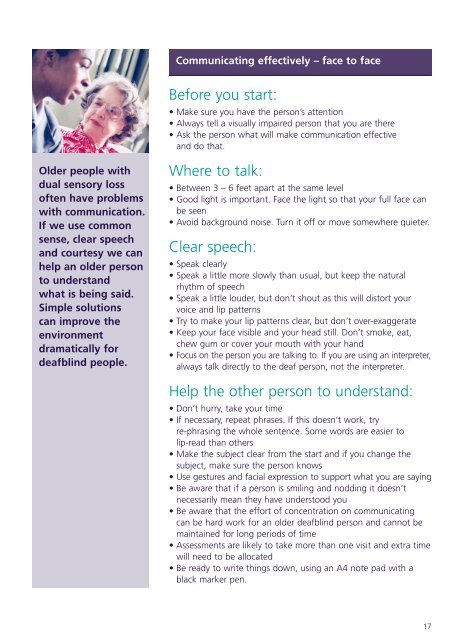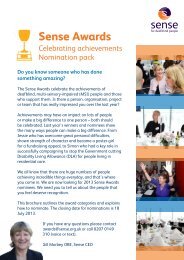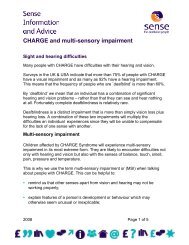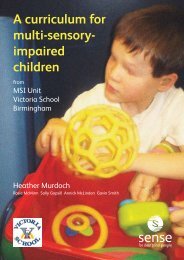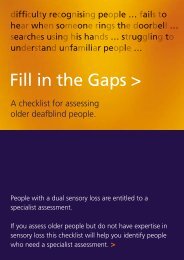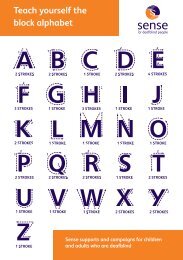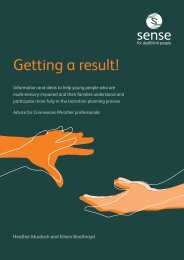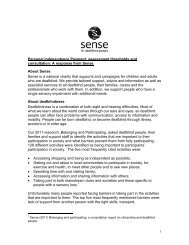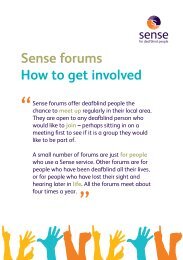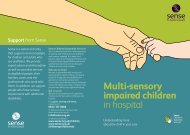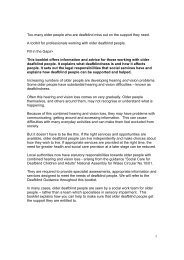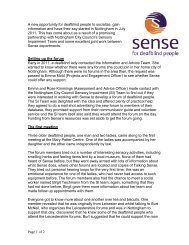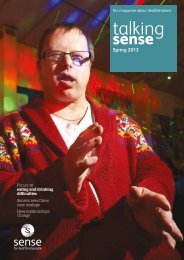Fill in the Gaps > Too many older people who are deafblind ... - Sense
Fill in the Gaps > Too many older people who are deafblind ... - Sense
Fill in the Gaps > Too many older people who are deafblind ... - Sense
Create successful ePaper yourself
Turn your PDF publications into a flip-book with our unique Google optimized e-Paper software.
Communicat<strong>in</strong>g effectively – face to faceBefore you start:• Make sure you have <strong>the</strong> person’s attention• Always tell a visually impaired person that you <strong>are</strong> <strong>the</strong>re• Ask <strong>the</strong> person what will make communication effectiveand do that.Older <strong>people</strong> withdual sensory lossoften have problemswith communication.If we use commonsense, clear speechand courtesy we canhelp an <strong>older</strong> personto understandwhat is be<strong>in</strong>g said.Simple solutionscan improve <strong>the</strong>environmentdramatically fordeafbl<strong>in</strong>d <strong>people</strong>.Where to talk:• Between 3 – 6 feet apart at <strong>the</strong> same level• Good light is important. Face <strong>the</strong> light so that your full face canbe seen• Avoid background noise. Turn it off or move somewhere quieter.Clear speech:•Speak clearly• Speak a little more slowly than usual, but keep <strong>the</strong> naturalrhythm of speech• Speak a little louder, but don’t shout as this will distort yourvoice and lip patterns• Try to make your lip patterns clear, but don’t over-exaggerate• Keep your face visible and your head still. Don’t smoke, eat,chew gum or cover your mouth with your hand• Focus on <strong>the</strong> person you <strong>are</strong> talk<strong>in</strong>g to. If you <strong>are</strong> us<strong>in</strong>g an <strong>in</strong>terpreter,always talk directly to <strong>the</strong> deaf person, not <strong>the</strong> <strong>in</strong>terpreter.Help <strong>the</strong> o<strong>the</strong>r person to understand:• Don’t hurry, take your time• If necessary, repeat phrases. If this doesn’t work, tryre-phras<strong>in</strong>g <strong>the</strong> <strong>who</strong>le sentence. Some words <strong>are</strong> easier tolip-read than o<strong>the</strong>rs• Make <strong>the</strong> subject clear from <strong>the</strong> start and if you change <strong>the</strong>subject, make sure <strong>the</strong> person knows• Use gestures and facial expression to support what you <strong>are</strong> say<strong>in</strong>g• Be aw<strong>are</strong> that if a person is smil<strong>in</strong>g and nodd<strong>in</strong>g it doesn’tnecessarily mean <strong>the</strong>y have understood you• Be aw<strong>are</strong> that <strong>the</strong> effort of concentration on communicat<strong>in</strong>gcan be hard work for an <strong>older</strong> deafbl<strong>in</strong>d person and cannot bema<strong>in</strong>ta<strong>in</strong>ed for long periods of time• Assessments <strong>are</strong> likely to take more than one visit and extra timewill need to be allocated• Be ready to write th<strong>in</strong>gs down, us<strong>in</strong>g an A4 note pad with ablack marker pen.17


